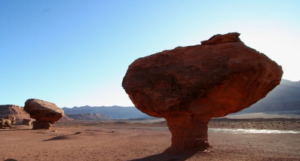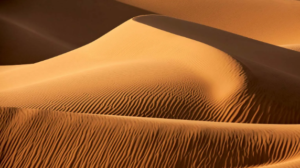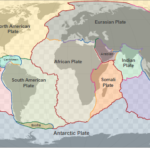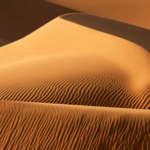The air current in motion is called “wind”. The wind is an important agent of erosion, transport and deposition. Its work is particularly seen in arid regions.
Wind Erosion
Although wind erosion is not restricted to arid and semiarid regions, it does its most effective work in these areas. Wind does erosion in three ways: (i) deflation, (ii) abrasion, (iii) attrition.
(1). Deflation: Lifting and removal of loose material by wind is called “deflation”. By this process, the land surface is gradually lowered. In many desert areas, deflation produces hollows or basins with their bottoms at the water table. Such basins containing some water called “oases”.
(2). Abrasion: During dust storms the wind carries minute grains of sand in suspension. They dash and collide against the exposed rock masses and cause erosion. This process in which sand grains are used as tools for eroding rocks, is called “abrasion”.
(3). Attrition: The particles that travel with wind, collide against one another. These mutual collisions lead to their further breakdown and the process is called “attrition”.
Erosional Features
The important features of wind erosion are the polishing of rock faces and the formation of ventifacts and pedestal rocks.
Ventifacts: Wind armed with sand abrades rock near the ground surface. This effect is called “sandblasting”. When pebbles and boulders are subjected to sandblasting they develop flat sides and sharp edges. If these stones contain coarse crystals of unequal hardness, they become pitted. Such stones, which are polished, pitted, and contain sharp edges are called “ventifacts”. These stones are faceted by erosion of their windward side.

Pedestal Rocks: Pedestal rocks are the undercut vertical columns of rocks, which have wider tops and narrower bases. When wind blows, the sand particles being heavy travel near the surface and cause undercutting of rock faces.

Wind Transport
Turbulent wind can easily sweep small dust particles and carry them to great distances in suspension. Sands, however, are transported in a series of jumps or these merely roll along the ground. The process by which sand particles travel in a series of jumps is called “saltation”. The greater part of the sand grains are transported very near the ground surface and they are seldom lifted more than a meter above the ground.
Wind Deposits
The wind deposits are commonly called the “eolian deposits. The rock particles in the eolian deposits are generally well-rounded and are sorted according to their size and weight. Wind deposits are of two types: (i) accumulations of sand, called “sand-dunes”, and (ii) deposits of silt, called “loess”.
Sand Dunes: The wind generally deposits sand in mounds. These mounds are called “sand dunes”. The sand traveling as a bed load in wind accumulates wherever it meets any obstruction, such as a boulder or a bush. As the accumulation of sand grows, it traps even more sand. In this manner, dunes are created. Sand dunes have a gentle slope (5° – 15°) on the windward side, and a steeper slope (20° – 30°) on the lee side. The height of a dune depends on the speed of wind and the size of sand grains. Dune heights of 30 meters are not uncommon. The sand dunes migrate slowly in the direction of wind movement. In some cases, they move as much as 20 meters per year. The migrating sand dunes may advance and cover farmland, railroads, highways, and other valuable properties. Their movement may be checked by planting vegetation. Read: Types of sand dunes

Loess: The suspended load transported by wind consists mainly of silt and dust particles. when it settles, it forms a blanket deposit of silt, known as “loess”. These deposits are typically non-stratified and have a grayish-yellowish color. Loess is composed of many minerals including quartz, felspar, hornblende, and calcite. These minerals are derived by wind from deserts or flood plains of rivers. Deposits of loess are very fertile. Loess deposits in some parts of China approach a thickness of 300 meters or more.

Other posts you may like:


Leave a Reply